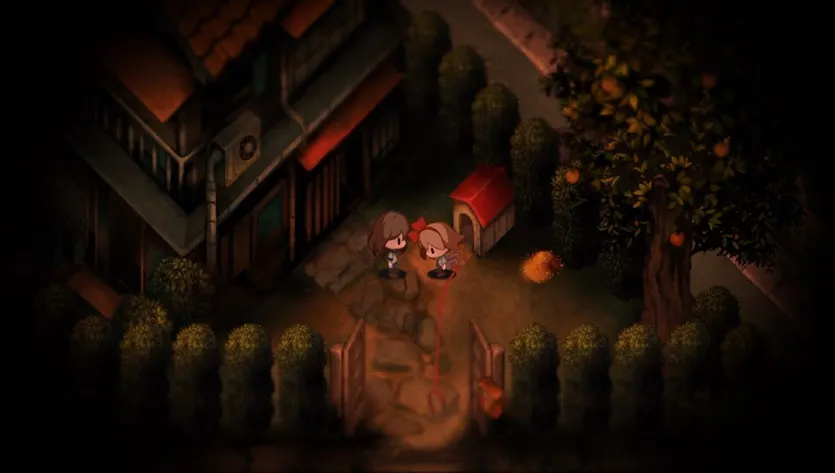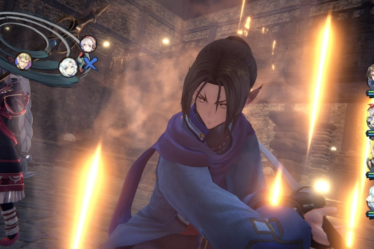
This article was originally published in Italian on Thegamesmachine.it in 2016.
Yomawari: Night Alone is yet another title published under the Nippon Ichi label that has made its way to the West in a futile attempt to make the Japanese software house known for something other than just the Disgaea franchise.
Given its similarities to The Firefly Diary (or htoL#NiQ), with which it is bundled in the physical edition, one might assume that this charming production—distributed in Europe by NIS America—was designed to take advantage of the Sony handheld’s brilliant screen. But nothing could be further from the truth: Yomawari: Night Alone not only fails to utilize any of the PS Vita’s unique features, but it also presents itself as a top-down walking simulator that, to the untrained eye, might resemble the mid-budget JRPGs cluttering Akihabara’s bargain bins. So much so that its release on the PS Store coincided with its launch on Steam, given how easy it was to port.
The tradition of indie horror games from Japan is filled with examples of titles that blend horror elements with the low-fi aesthetic of RPG Maker and similar tools. However, in the case of Yomawari: Night Alone, everything is depicted with a pleasing use of hand-drawn sprites, isometric perspective, and parallax effects, giving the young protagonist’s story a more than respectable presentation. Not surprisingly, the trailers that surfaced on YouTube in recent months seemed to suggest the arrival of a new little gem on the increasingly neglected Sony handheld. But is that really the case?
The nameless little girl featured in the promotional illustrations is, of course, the heroine of this adventure, which wastes no time in throwing her into a grim sequence of tragedies. The initial death of her loyal four-legged companion, followed by her sister’s disappearance and the appearance of monstrous spirits and creatures, is just the prelude to what can only be described as a dark journey through Japanese folklore and traditional ghost stories. Here, the hum of a vending machine by the roadside is accompanied by the sudden appearance of strange, bloodstained footprints on the asphalt or other assorted paranormal phenomena.
The game lacks complex dialogue or elaborate exchanges, with storytelling primarily driven by brief animations, the optional reading of collectible item descriptions, and the protagonist’s sparse diary entries. Each chapter—corresponding to a single night—begins with short, laconic notes and fleeting thoughts.
Unlike other similar titles, such as the classic Corpse Party (which made its way West after captivating thousands of players on PC and Sony PSP), Yomawari: Night Alone features no combat system, branching choices, or intricate narrative twists. Instead, it embraces a straightforward and relentless Trial and Error approach that, while reminiscent of old-school games, quickly becomes frustrating with no room for compromise. The protagonist’s only real action is running, managing stamina via one of the shoulder buttons. By timing sprints correctly and studying enemy movement patterns, players can gradually progress through the game, solving simple environmental puzzles—mostly involving finding objects and keys.
Emphasizing the heroine’s total inability to defend herself—armed only with items that are largely useless in direct confrontations—are the hiding spots, which are mostly repetitive environmental elements that serve as the only escape when an enemy is in pursuit. Failure to hide in time results in a gruesome death, followed by a quick respawn at the nearest checkpoint.
From a gameplay perspective, Yomawari does not offer a sufficiently complex system to sustain long-term engagement. However, the good variety of situations and the short length of the adventure ensure that, despite its simplicity, it remains entertaining—though never truly surprising. Death is a frequent occurrence in Yomawari, sometimes due to player carelessness, but more often because the game is designed to make players experience the grim fate awaiting a child caught in events far beyond her control. In this regard, I found the decision to retain progress and collected items even after a Game Over to be a lifesaver, ensuring that anyone can make it to the end credits. A more punishing approach would have undoubtedly ruined the balance of the experience, but the small team behind this title proved to be more competent than one might initially assume. The only real criticism is the lack of clear guidance throughout the game, often requiring players to advance blindly, hoping to stumble upon the event that moves the story forward, as the game offers no explicit direction on what to do next.
Though it lacks truly memorable elements, Yomawari: Night Alone benefits from excellent artistic direction and a strong sense of authorship, giving even the shortest play session a well-crafted atmosphere. The “kawaii” filter, which renders even the most grotesque monsters and long-haired spirits in a super-deformed style, works against the horror factor. However, it’s clear that the developers never intended to terrify players but rather to unsettle them—without resorting to gratuitous gore (as seen in Corpse Party) or breaking the delicate innocence conveyed through the protagonist’s eyes. If anything, Yomawari: Night Alone is a sort of naïve horror, if such a thing can be defined—certainly not something you see every day.
Yomawari: Night Alone may not stand out for any particular merits, but all things considered, it’s worth playing at least once, if only to appreciate its unique atmosphere. Since it doesn’t utilize any of the PS Vita’s exclusive features, Yomawari can be played just as comfortably on the handheld as on a PC, making this review just as relevant for the Steam edition.


